A Weekly CoinWeek Column by Greg Reynolds
News and Analysis regarding scarce coins, coin markets, and the coin collecting community #126 …..
Every September or October, the third Long Beach Expo of the year is held at the Long Beach Convention Center in the county of Los Angeles. This event is open to the public from Sept. 6th to Sept. 8th. As usual, Heritage is conducting the official auction while the Expo occurs.
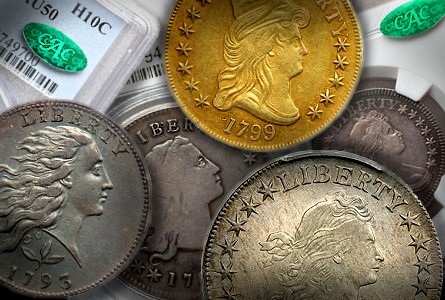 Also as usual, the Goldbergs are holding an auction in the city of Los Angeles just prior to the Long Beach Expo. The Goldberg auction runs from Sept. 2nd to 5th. My purpose here is to discuss many of the pre-1808 U.S. coins that will be offered in these two auctions, with emphasis on coins that are less expensive than most others of the same dates and types, respectively.
Also as usual, the Goldbergs are holding an auction in the city of Los Angeles just prior to the Long Beach Expo. The Goldberg auction runs from Sept. 2nd to 5th. My purpose here is to discuss many of the pre-1808 U.S. coins that will be offered in these two auctions, with emphasis on coins that are less expensive than most others of the same dates and types, respectively.
It is not practical for a preview to include a fair sample, statistical or otherwise, of the thousands of coins that will be auctioned from Sept. 2nd to Sept. 8th in Southern California. Although world coins will be offered, this discussion is limited to U.S coins. Moreover, there would be no point in even attempting to summarize the offerings of U.S. coins. Goldbergs and Heritage auctions are just too large to fairly or accurately summarize.
So, this discussion is limited to U.S. coins dating from 1793 to 1807, and not even all of them can be mentioned. There are many pre-1808 coins in this auction that are relatively affordable for coin issues from this time period.
While ‘early’ U.S. coins are generally categorized as pre-1840, or pre-1838, issues, those dating from 1793 to 1807 are often thought of as the earliest and constitute a specialty of their own. In several series, new design types were introduced in 1807 or 1808.
Generally, I prefer to discuss coins that I have personally examined. Regrettably, I will not be able to attend these events and I have seen only a small number of the coins that will soon be auctioned in Southern California.
So, even more so than usual, mentions of grades assigned by the PCGS or the NGC do not in any way imply that I am in agreement with such certified grades, though, on many occasions, I would find that I am in agreement if I saw the coins. In any event, I recommend that collectors purchase coins that are certified by the PCGS or the NGC, as acquiring such certified coins involves much less risk than the purchases of other coins.
I. Half Cents
The Goldbergs are offering a large collection of circulated half cents, which was assembled by “Carvin Goodridge.” Although “Goodridge” collected half cents by die variety, I suggest that those who collect half cents ‘by date’ or circulated half cents ‘by type’ consider some of the coins in this collection. This collection has tremendous depth and current market prices for circulated half cents are reasonable, from a logical perspective.
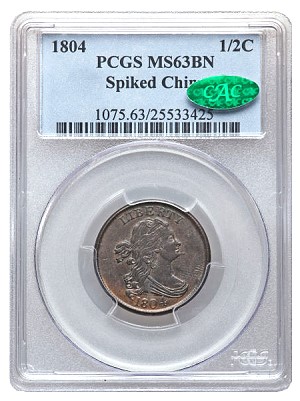 The U.S. Mint began operations in 1793, and half cents of 1793 are a one-year design type. Indeed, 1794 half cents look much different from 1793 half cents. The Goodridge collection includes well circulated 1793 half cents, which are great for people who cannot afford Extremely Fine or higher grade 1793 half cents.
The U.S. Mint began operations in 1793, and half cents of 1793 are a one-year design type. Indeed, 1794 half cents look much different from 1793 half cents. The Goodridge collection includes well circulated 1793 half cents, which are great for people who cannot afford Extremely Fine or higher grade 1793 half cents.
One that is graded “Fair-2” by the cataloguer (Bob Grellman?) is certainly identifiable as a 1793 half cent. Indeed, there is no doubt that it is a 1793 half cent. While it is difficult to predict the price that this piece will realize, it may be hard to find a readily apparent 1793 half cent, with much of its obverse design intact, for a lower price.
A 1793 half cent in this same collection that is graded AG-03 may be an even better value. It has the sharpness of a Good-06 or Very Good-08 grade coin, with some corrosion and verdigris. It may, though, be a really neat looking piece. Besides, it would be fun to own a 1793 half cent.
There are eight 1793 half cents in the Goodridge Collection, none of which are catalogued as grading higher than VG-08. For buyers who might not be able to afford a 1793 half cent in many other settings, this auction could present an excellent opportunity.
There are dozens of 1794 and 1795 half cents in the Goodridge Collection, some of which will sell for less than $500 each. Furthermore, there are, in this collection, more than twenty 1797 half cents, a few of which may sell for less than $200 each. There are not many 18th century U.S. coins that can be acquired for around $200!
As there are hundreds of half cents in this sale by the Goldbergs, it is not efficient to list them here. Many of these grade less than VF-20, though there are quite a few pieces of higher grades.
It is certainly newsworthy that the the Goodridge Collection contains more than twenty-five half cents of the scarce and very popular ‘Spiked Chin’ variety of 1804. Indeed, in this auction, ‘Spiked Chin’ half cents are available in a wide range of grades. When I was a kid, I was fascinated by this variety.
There are three ‘Spiked Chin’ 1804 half cents in the Heritage auction. One of the three is reported to be not gradable because of “rim damage,” and has the details of an Extremely Fine grade coin. It has been authenticated and encapsulated by experts at the NGC. While a really nice EF-40 grade 1804 ‘Spiked Chin’ may be worth more than $500, this one will bring a much lower price and may be a good value for a budget minded collector who desires a ‘Spiked Chin,’ as many collectors do.
The second ‘Spiked Chin’ Half Cent is NGC graded AU-50. The third is PCGS graded MS-63 and has a sticker of approval from the CAC. Heritage is offering quite a few other pre-1808 half cents. The Goldbergs are offering a massive number.
III. Large Cents
The Heritage offering of the “Philip Clover Collection of Large Cents” complements the offering by the Goldbergs of the “Carvin Goodridge Collection” of half cents. Both collections are extremely extensive, include many well circulated coins, and feature very impressive sets of die varieties.
Although Goodridge and Clover collected by die variety, I recommend that early copper enthusiasts collect ‘by date’ or ‘by type.’ Collectors of type coins are often focused on the three different types of large cents that were minted in 1793.
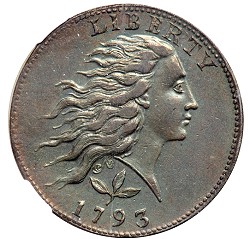 In the Heritage sale, there are six 1793 Chain Cents, fifteen 1793 Wreath Cents, and four 1793 Liberty Cap Cents. (Clickable links are in blue.) In 2008, I estimated that just three hundred 1793 Liberty Cap Cents exist in all grades, including the ungradable.
In the Heritage sale, there are six 1793 Chain Cents, fifteen 1793 Wreath Cents, and four 1793 Liberty Cap Cents. (Clickable links are in blue.) In 2008, I estimated that just three hundred 1793 Liberty Cap Cents exist in all grades, including the ungradable.
While these four 1793 Liberty Caps do not qualify for numerical grades, they might be excellent values for collectors who cannot afford much higher quality pieces of this issue. All four are of different die varieties and are in the “Philip Clover Collection of U.S. Large Cents.”
The Goldbergs are not auctioning any 1793 Liberty Cap Cents next week. They are offering two Chain Cents and nine Wreath Cents.
One of these Wreath Cents was recently in Denis Loring’s set of 1793 cents, which Heritage auctioned in Jan. 2012. It is NGC graded AU-55 and realized $40,250 in the Heritage FUN Platinum Night event. John Albanese then regarded the $40,250 result as a “strong price.” It is not of one of the rarer die varieties of Wreath Cents.
In the Goldberg sale, there are several 18th century large cents that are likely to sell for less than $200 each, maybe even less than $100 each. Many collectors find owning 18th century U.S. coins to be neat and enjoyable, even ones that are of low quality. If the central designs and dates are visible and the fields are not very rough, then the coins may be pleasing enough. In this category, there are four 1798/7 overdate cents, including one that is said by the cataloguer to have the sharpness of a Fine-12 grade and a net grade of ‘VG-07.’
In this sale, there is a 1798 Draped Bust Large Cent that was earlier in the Dan Holmes set of ‘early date’ large cents. It was graded by Bob Grellman as AG-03. Holmes bought this 1798 cent from Chris McCawley in 1997 for $45. In Sept. 2009, it realized $322. If it brings less than $322 next week, then it may be a good value for a collector who wishes to have a decent, 18th century cent, which is pedigreed to Dan Holmes, who is one of the most famous large cent collectors of all time.
All 1799 large cents are keys to the Draped Bust Cent series. In the Goldberg sale, there is one 1799/8 overdate and two 1799 normal date cents. In the Heritage sale, the “Philip Clover Collection” features two 1799/8 overdate cents and one 1799 normal date. The Heritage sale also includes a 1799 from an unnamed consignor. That one is PCGS graded ‘Fair-02.’
Both the Goldberg and Heritage sales include an assortment of pre-1808 large cents. Some are expensive and others are very inexpensive, in terms of current market values for early large cents.
III. Half Dimes
In the Goldberg sale, there is a 1795 Flowing Hair Half Dime that is PCGS graded MS-61 and is CAC approved. It is in an old PCGS holder with a green label. Further, it was earlier in the Superior Galleries auction of Oct. 1995, as were a significant number of other coins in the current Goldbergs auction. For most rare or scarce coins, prices were dramatically lower in 1995.
Flowing Hair Half Dimes were minted in 1794 and 1795. Dimes were not minted until 1796. Many people are not aware that half dimes existed before dimes did, and that half dimes weigh about half as much as corresponding dimes.
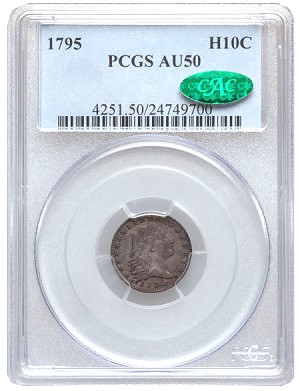 Heritage will auction a 1794 half dime that is said by experts at the NGC to be “damaged” and to have the ‘details’ of a Fine grade coin. While this coin has some substantial problems, it is not bad looking. It is more attractive than some 1794 half dimes that have received numerical grades from the NGC or the PCGS.
Heritage will auction a 1794 half dime that is said by experts at the NGC to be “damaged” and to have the ‘details’ of a Fine grade coin. While this coin has some substantial problems, it is not bad looking. It is more attractive than some 1794 half dimes that have received numerical grades from the NGC or the PCGS.
Three 1795 half dimes will be offered by Heritage. One, from the “Fred Yee Collection,” is NGC certified as being “Improperly Cleaned” with the ‘details’ of an uncirculated coin. While viewing images, I did not get a good feeling about it. The color and texture may be very unnatural. Even so, it would be a mistake to draw a firm conclusion about the appearance and other physical characteristics of a coin from images, even from extraordinarily sharp images on the Heritage website.
A second 1795 is NGC graded VF-20. The third is PCGS graded AU-50 and is CAC approved. The third is likely to be much more expensive than the other two, though perhaps ‘worth it’ to the wealthy buyer who can afford it.
Draped Bust, Small Eagle Half Dimes were minted in 1796 and 1797. The 1796 of the ‘LIKERTY’ variety is popular. There was a problem with the punch for the letter ‘B’ in Liberty. On these half dimes, the ‘B’ looks like a ‘K’. This variety is rare.
Fred Yee’s 1796 is more impressive than his 1795. It is NGC graded MS-60. There is no reserve and bidding has already reached $14,100, as of Tuesday afternoon, Aug. 28th. The level will probably rise.
A 1797 from an unnamed consignor has been determined to be not gradable by experts at the NGC, who state that it has the details of an Extremely Fine grade coin. While this coin has been abused, it may turn out to be an excellent value for a collector who does not wish to spend a much larger amount for an EF-40 grade 1797 half dime.
Draped Bust, Heraldic Eagle Half Dimes were minted from 1800 to 1805. Fred Yee’s 1800 is not gradable, yet its details are extremely sharp. The NGC holder indicates that it is :uncirculated.” It will be interesting to find out how it fares in this auction.
An 1802 half dime is perhaps the most famous coin in the Heritage sale. (Please read my discussion of the 1802 that Heritage auctioned in January 2012.) This one is in a PCGS ‘Genuine’ holder, which states that it is ‘bent’ and has the details of an Almost Good grade coin. Bidding has already reached $28,200. Plus, an 1803 in a PCGS Genuine holder seems attractive.
IV. Dimes
The 1796 dime in the Heritage sale is a reminder of the importance of buying coins in PCGS or NGC holders. Pictures may suggest to some people that it is a very sharp 1796 dime, with very few contact marks, that merits a high numerical grade. As the printed label inside the NGC holder states, however, it has been ‘repaired’ and has the details of an AU grade coin. In another setting, this coin might have been represented by an unethical or unknowing seller as an AU-55 1796 dime.
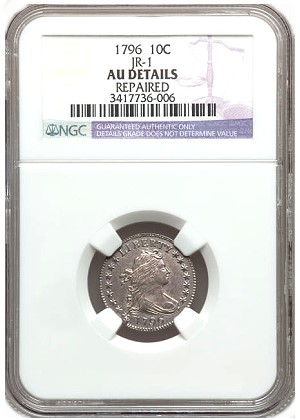 Indeed, there are dealers of uncertified coins who may remove it from its holder and represent it as an AU-55 or higher grade coins without disclosing that it has serious problems. This ‘repaired’ 1796 dime is also from the Fred Yee Collection. I hope that he was aware of this coin’s problems when he bought it. Nonetheless, for a modest price, it may be an excellent purchase for a collector who does not wish to spend more than $16,000 for a gradable 1796 dime with similar design details.
Indeed, there are dealers of uncertified coins who may remove it from its holder and represent it as an AU-55 or higher grade coins without disclosing that it has serious problems. This ‘repaired’ 1796 dime is also from the Fred Yee Collection. I hope that he was aware of this coin’s problems when he bought it. Nonetheless, for a modest price, it may be an excellent purchase for a collector who does not wish to spend more than $16,000 for a gradable 1796 dime with similar design details.
There are two 1798/7 Draped Bust, Heraldic Eagle Dimes in this sale. One is NGC graded AU-53. The other is PCGS graded AG-03 and has a CAC sticker.
An 1800 dime that is PCGS graded AG-03 will probably sell for a price between $300 and $500. This Heritage sale also contains three 1805 dimes, NGC graded MS-64, PCGS graded Fine-15, and an NGC authenticated 1805 that is not gradable, with Fine level details.
There are two 1807 dimes in this sale. One is PCGS graded MS-65 and the other is NGC graded AU-55.
Although the coin auctions in September will not be remembered for dimes, budget-minded collectors who seek circulated Draped Bust Dimes may find some pieces that they like for reasonable prices. Not every collector can afford the amazing dimes that sometimes appear in FUN or ANA auctions.
V. Quarters
As 1796 is the first year for dimes, it is also the first year for quarters. The quarters of 1796, though, are one-year type coins, with a ‘Small Eagle’ reverse. Quarters were not minted again until 1804, when the Heraldic Eagle reverse design appeared on quarters.
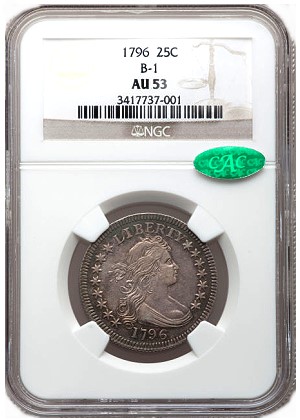 There are two 1796 quarters in the Heritage auction. One is NGC graded AU-53 and is CAC approved. This is probably one of the more exciting coins in the Fred Yee Collection.
There are two 1796 quarters in the Heritage auction. One is NGC graded AU-53 and is CAC approved. This is probably one of the more exciting coins in the Fred Yee Collection.
The other 1796 is in very bad shape. For someone who wishes to acquire an authenticated and encapsulated 1796 quarter for the lowest possible price, this coin might be well suited.
In the Heritage auction, there are three 1805 quarters, all PCGS graded, Good-04, Fine-12 and VF-30, respectively. There are also three PCGS graded 1805 quarters in the Goldberg sale, VG-10, VF-35 and AU-50, respectively.
The Goldbergs are also offering an 1806/5 overdate and an 1806 normal date that are each PCGS graded VG-10 and CAC approved. The 1806/5 in the Heritage Long Beach auction is NGC graded AU-58.
Curiously, Heritage is offering five 1806 normal date quarters. The listing that grabbed my attention is a PCGS graded Poor-01 1806 that has been CAC approved. In other circumstances, it may be difficult to locate a gradable quarter of the Draped Bust, Heraldic Eagle design type that might very sell for less than $100!
VI. Half Dollars
Like corresponding half dimes and silver dollars, Flowing Hair Half Dollars were minted in 1794 and 1795. While 1794 halves are very scarce, a sizeable number of Flowing Hair 1795 Half Dollars survive. This Heritage auction has seven of them. Other Heritage auctions have contained even more.
 Draped Bust, Heraldic Eagle Half Dollars date from 1801 to 1807. There is an 1801 in the Goldberg sale that is NGC graded Very Good-08.
Draped Bust, Heraldic Eagle Half Dollars date from 1801 to 1807. There is an 1801 in the Goldberg sale that is NGC graded Very Good-08.
There are two 1802 halves in the Heritage auction, both are graded VF-35, one by the PCGS, the other by the NGC. There are three 1803 half dollars in this same sale and two 1805 halves. The first 1805 is PCGS graded VF-20 and the second is not gradable. Its NGC holder indicates that 1805 has the ‘details’ of a Very Fine grade coin.
In the Heritage sale, an 1806/5 overdate is PCGS graded AU-50. In the Goldberg sale, there is an 1806/5 that is not gradable and has been determined by experts at the NGC to have the ‘details’ of an AU grade coin.
In 1999, Superior Galleries auctioned the Dr. Juan Suros Collection of overdates. It is interesting that he formed an extensive collection of overdates of many design types, including Great Rarities like an 1825/4 Half Eagle and the Eliasberg 1817/4 half dollar.
In this Heritage Long Beach auction, there are seven 1806 normal date halves of the ‘pointed 6’ variety and an 1806 half of a different variety. There are also being offered two not gradable 1807 Draped Bust, Heraldic Eagle Half Dollars, one with “VG Details” indicated on a ‘PCGS Genuine’ label. This coin will be a very good value if the price stays below $100. The other is in an NGC holder, which refers to it as having the details of an Extremely Fine grade coin.
The Goldbergs are offering two, gradable 1807 Draped Bust, Heraldic Eagle Half Dollars. The first, from “The Stocker Estate,” is PCGS graded MS-62. The second is PCGS graded VF-35.
Although part of the purpose of a discussion of pre-1808 U.S. coins is to focus on Flowing Hair and Draped Bust types, rather than Capped Bust types, it is true that Capped Bust Half Dollars were first minted in 1807. At Long Beach, Heritage will be auctioning three 1807 Capped Bust Half Dollars, NGC graded VF-20, PCGS graded VF-35 and PCGS graded EF-45, respectively.
VII. Silver Dollars
Although there are probably fewer than one hundred and fifty 1794 Flowing Hair Silver Dollars in existence, there survive thousands of 1795 Flowing Hair Silver Dollars. Collectors often acquire representatives of both ‘Two Leaves’ and ‘Three Leaves’ varieties. These terms refer to the number of leaves under each wing of the eagle. As the ‘Two Leaves’ variety is scarcer, collectors of type coins will tend to choose a 1795 Flowing Hair Dollar of the ‘Three Leaves’ variety.
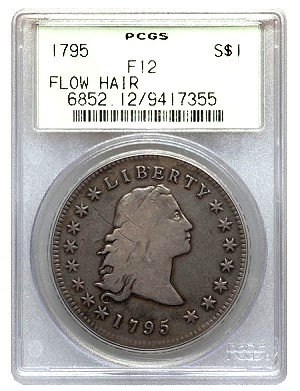 In this auction, Heritage is auctioning six representatives of the ‘Three Leaves’ variety, two of which are not gradable. The highest certified of the six is NGC graded “AU-55+.” The Goldbergs are offering one that is PCGS graded EF-40.
In this auction, Heritage is auctioning six representatives of the ‘Three Leaves’ variety, two of which are not gradable. The highest certified of the six is NGC graded “AU-55+.” The Goldbergs are offering one that is PCGS graded EF-40.
There are also Draped Bust Silver Dollars that are dated 1795. Heritage will offer two of them, one is said by experts at the NGC to have the details of a Very Fine grade coin. The other is NGC graded AU-55.
As for 1796 Draped Bust, Small Eagle Silver Dollars, there are major and minor varieties. Collectors who are not sure about them should not pay a premium for a 1796 dollar because of its variety. The major varieties are worth, more or less, the same in most circulated grades. Heritage is offering a 1796 of the ‘Small Date, Large Letters’ variety that is PCGS graded EF-40.
The major and minor varieties of 1797 dollars, and there corresponding values, are a little more confusing than the varieties of 1796 dollars. Usually, the variety with ten stars on the left and six stars on the right, is less costly than other 1797 dollars of very similar quality. Heritage is offering five 1797 dollars, including three of this ‘ten stars by six stars’ variety. These are among the least expensive representatives of the Draped Bust, Small Eagle Silver Dollar type.
Business strikes of the Draped Bust, Heraldic Eagle type date from 1798 to 1803. These are not rare. (Proofs are a very different topic.)
Heritage is offering six 1798 dollars in this auction. The Goldbergs are offering one that is PCGS graded AU-55 and is CAC approved. Regarding all bust half dollars and bust silver dollars, it is important to keep in mind that rare die varieties will, in some cases, be worth much more than the least scarce die varieties of the same respective dates.
There are three 1799 dollars in the Goldberg auction. It has been determined that all three are not gradable. Two are in PCGS ‘Genuine’ holders and one is in an NGC ‘details’ holder.
Offerings of ungradable 1799 dollars sometimes present opportunities for collectors to acquire an 18th century silver dollar at a price that is much lower than a clearly, gradable 1799 dollar would cost. Though I personally prefer dimes, quarters and half dollars, silver dollars are very popular and 1799 dollars have the added allure of an 18th century date. There are nine 1799 dollars in the Heritage Long Beach auction.
There are four 1800 dollars in this Heritage auction, all of which have been found by experts at the NGC to be not gradable. The Goldbergs are offering an 1800 that is PCGS certified as being ‘genuine’ with the details of a Very Fine grade coin.
In the Heritage auction, there are not gradable 1801 and 1802 dollars, plus an 1802 that is NGC graded VF-25. Also, there will be offered two NGC graded 1803 dollars, VF-25 and VG-08. Overall, there are significant selections of relatively affordable, circulated bust dollars in these two auctions.
VIII. Gold
Half Eagles ($5 gold coins) and Eagles ($10 gold coins) were first minted in 1795. Production of Quarter Eagles ($2½ gold coins) began in 1796.
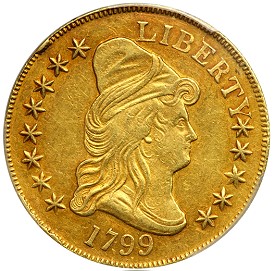 There are three pre-1808 Quarter Eagles in the Heritage auction. A 1798 Quarter Eagle has been “damaged,” according to experts at the NGC, with the details of a Very Fine grade coin. Nonetheless, 1798 Quarter Eagles are extremely rare. Depending upon the price realized and the objectives of the buyer, this coin may turn out to be a great value for someone who cannot afford a 1798 that would qualify for a numerical grade from the PCGS or the NGC, especially for a collector who is seeking to build a set of Bust Quarter Eagles.
There are three pre-1808 Quarter Eagles in the Heritage auction. A 1798 Quarter Eagle has been “damaged,” according to experts at the NGC, with the details of a Very Fine grade coin. Nonetheless, 1798 Quarter Eagles are extremely rare. Depending upon the price realized and the objectives of the buyer, this coin may turn out to be a great value for someone who cannot afford a 1798 that would qualify for a numerical grade from the PCGS or the NGC, especially for a collector who is seeking to build a set of Bust Quarter Eagles.
In this Heritage sale, an 1802/1 overdate is NGC graded AU-55. An 1807 is in a PCGS ‘Genuine’ holder with the notation that it has the details of an AU grade coin. I have been emphasizing, for years, that early Quarter Eagles are truly rare. Indeed, Bust Quarter Eagles are a very challenging series.
There are also three pre-1808 Half Eagles ($5 gold coins) in this Heritage Long Beach auction. A 1799 is in an NGC holder that indicates that it has been ‘repaired’ and has the ‘details’ of an AU grade coin. An 1805 is PCGS graded MS-62 and is CAC approved. A Bust Left 1807 is in a PCGS ‘Genuine’ holder and is “uncirculated.”
The Goldbergs and Heritage are each offering two 18th century Eagles. Both of those in the Heritage sale are certified as being not gradable, a 1797 has ‘AU details’ and a 1799 is in a “PCGS Genuine” holder that states “Damage – VF Details.”
The Goldbergs are offering a 1795 Eagle that is also not gradable. Its NGC holder indicates that it has the ‘details’ of an AU grade coin. This issue is famous, rare and very popular. A 1799 Eagle is PCGS graded AU-50.
Of course, there are wide variety of U.S. coins and other numismatic items in these two auctions. One reason that I focus upon the offerings of circulated pre-1808 coins is that, among coins in these two auctions in this category, there are likely to be some really good values for collectors, especially for respective coin issues that would cost dramatically more in better states of being. Additionally, the Goodridge Collection of half cents and the Clover Collection of large cents each present a multitude of opportunities for non-wealthy collectors to acquire pre-1808 U.S. coins for relatively modest prices.
©2012 Greg Reynolds




